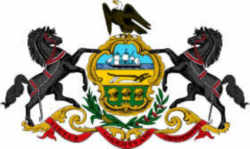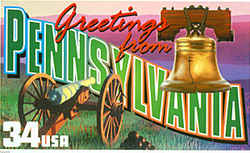- » 50 States »
- » Histories »
- » State Symbols »
- » Mottos
Pennsylvania State Motto
"Virtue, Liberty, and Independence"

Adopted in 1875.
Language: English
Focus: Liberty and Freedom
See Pennsylvania State Flag
The motto, Virtue, Liberty and Independence, first appeared on the Pennsylvania coat of arms designed by Caleb Lownes in 1778. Between 1778 and 1873, numerous modifications and changes were made to the coat of arms until, in 1874, the Pennsylvania Legislature appointed a commission to establish an official version. In 1875, the commission adopted a coat of arms virtually identical to the design established by Mr. Lownes in 1778.
Pennsylvania State Motto
"Virtue, Liberty, and Independence"
These a states with mottos that focus on liberty.
- Delaware: "Liberty and Independence"
- Iowa: "Our Liberties We Prize, and Our Rights We Will Maintain"
- Massachusetts: "Ense petit placidam sub libertate quietem"
(By the Sword We Seek Peace, but Peace Only under Liberty) - New Jersey: "Liberty and Prosperity"
- North Dakota: "Liberty and Union Now and Forever; One and Inseparable"
- Pennsylvania: "Virtue, Liberty, and Independence"
Pennsylvania's Coat of Arms
Pennsylvania's Coat of Arms, while not used in the same official capacity as the State Seal (although it contains the emblems of the seal), is perhaps a more familiar symbol of the Commonwealth of Pennsylvania. It appears on countless documents, letterheads, and publications, and forms the design on Pennsylvania's State Flag. Provincial Pennsylvania's coat of arms was that of the Penn family. A state coat of arms first appeared on state paper money issued in 1777. This first coat of arms was nearly identical to the State Seal, without the inscription. In 1778, Caleb Lownes of Philadelphia prepared a coat of arms. Heraldic in design, it consisted of: a shield, which displayed the emblems of the State Seal --- the ship, plough, and sheaves of wheat; an eagle for the crest; two black horses as supporters; and the motto "Virtue, Liberty and Independence." An olive branch and a cornstalk were crossed below the shield. Behind each horse was a stalk of corn, but these were omitted after 1805.
Numerous modifications were made to this coat of arms between 1778 and 1873, chiefly in the position and color of the supporting horses. In 1874, the legislature noted these variations and the lack of uniformity and appointed a commission to establish an official coat of arms for the Commonwealth. In 1875, the commission reported that it had adopted, almost unchanged, the coat of arms originally designed by Caleb Lownes ninety-six years earlier.








